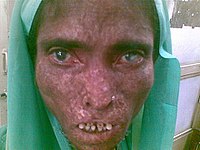
Photo from wikipedia
Abstract Background Mycobacterium hemophilumis a slow growing non-tuberculous mycobacterium that has predilection for lower temperatures and extremities. It presents commonly as a cutaneous infection but can have a variety of… Click to show full abstract
Abstract Background Mycobacterium hemophilumis a slow growing non-tuberculous mycobacterium that has predilection for lower temperatures and extremities. It presents commonly as a cutaneous infection but can have a variety of clinical presentations in immunocompromised patients. Methods We present a patient found to have disseminated Mycobacterium hemophiluminfection with a presentation similar to lepromatous leprosy. Results A 60 year-old man with a history of psoariatiform dermatitis and end stage renal disease. He received a deceased donor renal transplant in 2005 from China, complicated by chronic allograft dysfunction. He previously worked as an architect and apart from travel to China in 2005 did not travel to other leprosy endemic regions nor have contact with patients known to have leprosy. Despite medical therapy, he was reinitiated on dialysis 11 years after transplantation via a permanent catheter. He was on prednisolone, ciclosporin and MMF that ceased at time of reinitation of dialysis. He presented 4 months later with bilateral foot gangrene and an erythematous macular rash over his face and right upper limb. This was deemed to be drug related initially and he was treated with topical agents. His rash worsened with new nodular lesions over his chest, torso and lower limbs with facial and ear lobe involvement. He was also noted to have flattening of his nasal bridge that appeared saddle like. He was also noted to have wasting of bilateral intrinsic muscles of his hands with a right ulnar claw. This was thought to be in keeping with lepromatous leprosy. He underwent a skin biopsy that showed numerous acid fast bacilli with no formed granulomas. This grew Mycobacterium hemophilum and PCR for Mycobacterium leprae was negative. Nasal swabs and blood cultures also grew Mycobacterium hemophilum. Tissue cultures from his foot gangrene also grew Mycobacterium hemophilum. He was started on rifampicin, ciprofloxacin and clarithromycin. Despite medical therapy, he demised a month later from hospital acquired pneumonia. Conclusion Mycobacterium hemophilum can present with cutaneous lesions and neurological signs that can resemble lepromatous leprosy. High index of suspicion, good travel and exposure history, as well as obtaining specimens for culture would be essential in suspicion and diagnosis. Disclosures All authors: No reported disclosures.
Journal Title: Open Forum Infectious Diseases
Year Published: 2017
Link to full text (if available)
Share on Social Media: Sign Up to like & get
recommendations!